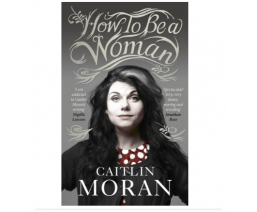Reclaiming the F-word

Review: How to be a Woman, Caitlin Moran, Ebury Press.
The widespread rejection of feminism, particularly by younger women, is a phenomenon evinced by the standard discussion opener, “I’m not a feminist but...”, with feminists pointing out that feminism itself has become a dirty word; the F-word of an apolitical generation whose collective false consciousness continues to perpetuate a disavowal of the women’s movement. And yet, when particular issues, such as reproductive freedom, political representation, and sexual violence are broached, women, of all ages seem to share explicitly feminist views, much in the vein of even the most ardent Germaine Greers or Kate Milletts of this world.
The difficulty, then, must lie with the term, feminism, which has borne the brunt of reactionary and insidious delegitimation, as Susan Faludi so brilliantly described in Backlash: The Undeclared War Against Women. Stereotypes of feminists as dungaree-wearing man-hating women-beasts are replete with the sexist assumptions feminism seeks to undermine.
It is therefore refreshing and timely for Caitlin Moran’s book, How to Be a Woman, to make a splash on the bestseller lists this summer with a wholehearted embrace of both the word, feminism, and the liberatory beliefs it entails. Indeed, references to “women’s liberation”, “consciousness-raising”, and “patriarchy” are unashamedly brandished throughout, punctuating her often hilarious autobiographical tales of maturation from dreary puberty (“sex hormones are a bitch that have turned me from a blithe child into a bleeding, weeping, fainting washerwoman”) to rock’n’roll adulthood (“whilst it’s easy to slide into a gin-sodden, decade-long bout of Lego-stippled self-pity, I prefer to look at the whole business of being a mother from a more positive angle”).
She covers the complex topics of women’s objectification in the media, parenting, abortion, and marriage, amongst others, with an intense passion for the realisation of gender equality, and surely manages to convince even the most sceptical of readers of its merits through her comedic talent, which makes one, from the get-go, want to be on Moran’s side. Who could fail to laugh at her description of a wedding reception – “a uniformly high-heeled occasion” – as the “annual AGM of the Tina Turner Impressionist Union”, or the assessment of her teenage flirting skill as being “very, very rudimentary...the majority of it revolv[ing] around ‘bold’ winking, a bit like a mad pirate”?
Squeamish readers, though, beware: Moran’s writing is not for the easily shocked. Intimate details on menstruation, masturbation and cystitis – to name but a few – are discussed and interspersed with the odd willy or boob joke. While this might be off-putting to some, it is consistent with Moran’s rationale for the book: to speak about issues which are rarely publicly discussed by women, which are significant from a feminist perspective, and which we therefore ignore at our peril. Pornography, Katie Price (aka Jordan), plastic surgery, Brazilian waxing – these are all topics relevant to women, and, increasingly, girls today, and Moran wishes to break the silence surrounding such phenomena, while highlighting, in a humorous manner, the sexism which sustains them.
While this is of course a laudable task, and Moran deserves credit for bringing feminism to a mainstream audience through her pop-culture memoir, it is unfortunate that she somewhat overstates the silence on contemporary feminist issues, and her pioneering role in uncovering same. She argues, for example, that feminism has “ground to a halt” with a “couple of increasingly small arguments” being “carried out among a couple of dozen feminist academics.” Besides the fact that feminism has flourished in academia, particularly over the last decade before the financial crisis, and that many young women and men now encounter feminism for the first time during their third level studies, there is ample evidence for the proliferation of feminist texts, and intense activism - aided particularly through blogs and social media sites - by feminists the world over.
There are also some clunkers in the book, such as her incongruous references to Third World women, or her comparison of India’s and Pakistan’s partition with skimpy knickers, and one remains unconvinced that sexism is somehow related to rudeness and can be addressed through an increase in manners. To be fair, this is not the only assessment of patriarchy Moran provides, and her writing is unequivocally a call for women’s (re)discovery of feminist principles and language. Outraged at the low numbers of women willing to call themselves feminists (29% in the U.S. and 42% in the U.K.), she asks “What do you think feminism IS, ladies? What part of ‘liberation for women’ is not for you?” and concludes that the debate is moot anyhow, as “without feminism, you wouldn’t be allowed to have a debate on woman’s place in society”. How to be a Woman thus questions and challenges women’s uneasiness with the F-word and all it stands for, but does so in an entertaining and enjoyable manner.
There are increased signs that the period of eschewing feminism is in decline, and certainly in Ireland, groups like the Irish Feminist Network and Cork Feminista constitute apt examples of people’s growing interest in and support for feminism. Caitlin Moran’s high-profile book rides the crest of this new trend toward rather than away from feminism, as she imbues it with her own brand of shabby-chic coolness. For the uninitiated, but intrigued, this book forms an accessible introduction to some of the values and ideas of feminism; importantly, though, it also simply constitutes a funny account of a woman’s developmental escapades, which is enormously pleasurable to read.
Clara Fischer is a coordinator of the Irish Feminist Network. This piece was originally published on the Irish Feminist Network blog.
